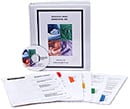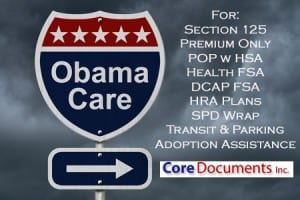Home / Blog / How Employers Offset Portions of ObamaCare Rate Hikes
How Employers Offset Portions of ObamaCare Rate Hikes
Employers nationwide are learning how to offset portions of ObamaCare rate hikes to health insurance premiums by reducing payroll taxes with Section 125 Cafeteria Plans. In many cases, employer savings can add up to as much as 20 percent of every dollar being passed through the plan.

Bradenton, FL October 4, 2013 – Today, Core Documents, the nation’s primary provider of affordable Section 125 Cafeteria Plan documents and HRA Plan Documents announced strategies employers nationwide are using to cope with huge ObamaCare insurance premium increases.
One of the most underused employee benefits for small businesses today is the Section 125 Cafeteria Plan. These plans simply allow employees to withhold a portion of their salary on a pre-tax basis to cover the cost of qualifying insurance premiums, medical expenses and dependent care expenses. Because Section 125 Cafeteria Plan benefits are free from federal and state income tax, an employee’s taxable income is reduced which increases their take-home pay. And because the Section 125 Cafeteria Plan reduces employee gross income for purposes of income tax, the employer also enjoys a reduction in their payroll tax liability by eliminating matching FICA taxes of 7.65%, and possibly workers’ compensation (depending on your state).
In the reality of ObamaCare induced, out-of-control health insurance rate hikes, employers nationwide are rushing into Section 125 Cafeteria Plans to get some relief. They’re realizing they can offset a good portion of their insurance premium increases with reduced payroll tax liabilities. Seems simple; and it really is. The reason more employers don’t take advantage of Section 125 Cafeteria Plans is because they believe they’re too difficult to setup or administer, most CPAs don’t really understand them or offer assistance, and most insurance agents don’t make a commission on Section 125 Cafeteria Plans so they don’t bother taking the time to explain the concept.
As succinctly, as possible, here’s what you need to know about the three different benefits that make up a full Section 125 Cafeteria Plan (keep in mind you can implement just one, all, or any combination of these three plans):
1. Pre-tax health insurance premium deductions, also known as a Premium Only Plan (POP). POP plans allow employees to elect to withhold a portion of their pre-tax salary to pay for their premium contribution for most employer-sponsored health insurance plans. The plan offers a simple way to obtain favorable tax treatment for benefits already offered. A POP plan is the simplest type of Section 125 plan and requires little maintenance once it’s been set up through payroll. Section 125 POP plans reduce employer payroll tax liabilities. The cost to implement just a POP plan is only $99.00 in PDF version, or $149 in the deluxe 3-ring binder printed version delivered by Priority Mail AND the PDF version emailed as soon as your document is completed. See webpage at www.Core125.com and the Online Order Form or the Fax Order Form
2. Out-of-pocket unreimbursed medical expenses also known as Health flexible spending accounts (FSAs). A Health FSA, authorized under IRC Section 105 and 106, allows an employee to pay for certain medical expenses on a pre-taxed basis through salary reduction. Effectively the employee pays for out-of-pocket expenses that aren’t covered by insurance (for example, annual deductibles, office co-payments, prescriptions, over-the-counter drugs and orthodontia) with dollars set aside in a tax free account. By participating in a FSA, an employee’s taxable income is reduced, which increases the percentage of pay they take home. This, of course, also reduces employer payroll tax liabilities. The cost to implement a Health FSA is only $129.00 in PDF version, or $179 in the deluxe printed version in a 3-ring binder deivered by Priority Mail AND the PDF version delivered by email as soon as your document is completed. See www.CoreFSA.com or the Health FSA Online Order Form or the Health FSA Fax Order Form.
3. Dependent Care Assistance Plan flexible spending accounts (FSA). The Dependent Care Assistance Plan (DCAP) FSA, authorized under IRC Section 129, is an attractive benefit for employees who pay for child-care or adult daycare for their parents. Many employees don’t take advantage of this benefit and may be unaware of the significant tax savings. Employees may hold back as much as $5,000 annually of their pre-tax salary for dependent care expenses, which include expenses they pay while they work, look for work or attend school full time. Qualified dependent care expenses may include, but are not limited to, the care of a child under the age of 13, daycare for parents, care for a disabled spouse or a dependent incapable of caring for himself, and summer day camps. In addition, by paying for dependent care with pre-taxdollars, your employees can save approximately 20 to 40 percent on their child-care expenses. This of course also reduces employer payroll tax liabilities. The cost to implement a DCAP FSA plan is $129.00 in PDF version, or $179 in the printed deluxe version in a 5-tab 3-ring binder delivered by Priority Mail, AND the PDF version delivered by email as soon as your document is completed. See more information at Core DCAP.com and the DCAP Online Order Form or the DCAP Fax Order Form
If you purchase all three modules together as a full Section 125 Cafeteria Plan you receive a $58 discount for a total cost of only $299.00 in PDF version processed quickly, or $349 in the deluxe printed version with 5-tab 3-ring binder delivered by Priority Mail, AND the PDF version delivered by email as soon as your document is completed. Or a combination of two FSA plans is only $249.00 in PDF version, and a POP and FSA combo for $199.00 in PDF version.
The best part about the Section 125 plan is that most of your employees are already paying for these expenses out of their own pockets with after-tax dollars. Cafeteria plans offer them a remarkably easy way to save money they’re already spending.
Here’s how the Section 125 FSA component works:
1. Prior to the beginning of each plan year, an employee estimates how much they’ll spend in out-of-pocket medical expenses and/or dependent care expenses during the course of their plan year. (The plan year would be defined in their summary plan description).
Note: It’s important for employees not to overestimate their annual election amounts, as the FSA is a “use it or lose it” benefit and they’ll forfeit any unused balance remaining in the account at the end of each plan year.(There’s a grace period for which an employee can file claims for each plan year.) If there’s a FSA surplus at the end of the plan year, the remaining balance shall be retained by the employer to offset administrative expenses or future employee benefit costs.
2. This amount is then deducted over the course of the plan year from their paychecks prior to being taxed and is deposited into their flexible spending account. On or after the first day of the plan year, an employee is restricted from changing or revoking the section 125 agreement with respect to the pre-tax premiums until the plan year has ended unless a “change in family status” occurs (as defined under the federal tax code) and the change is consistent with the “change in family status.”
3. Your employees would pay their out-of-pocket expenses upfront and then submit a claim and documentation to the plan administrator. A reimbursement would then be made from their own Health FSA or DCAP account with pre-taxed dollars and sent to them in the form of a check.
So what are the Section 125 Cafeteria Plan benefits to you as the employer?
1. Every dollar ran through the Section 125 plan reduces an employer’s payroll. Therefore, you don’t have to pay FICA or workers’ comp premiums (depending on your State) on those dollars. In many cases, this savings can add up to as much as 20 percent of every dollar being passed through the plan.
2. Implementing a Section 125 Cafeteria Plan can “soften the blow” of premium increases to employees.
And what are the Section 125 Cafeteria Plan benefits to your employees?
1. Participating in a cafeteria plan reduces an employee’s taxable salary and increases the percentage of their take-home pay, thus increasing their spendable income.
2. They receive a greater deduction on dependent care expenses than what’s offered by a traditional tax credit at the end of year.
3. There’s less of an impact on employees from insurance increases, such as premiums, co-pays, deductibles and so on. One of the most common ways for employers to keep benefit costs down is to simply lower the benefit levels of their plan offering. While this saves you money on your premiums, your employees are then faced with greater deductibles, higher co-pays, higher prescription amounts and so on. Through the use of a Health FSA, employees can set aside money to cover these increased amounts, which lessens their out-of-pocket costs because they’re setting aside tax-free dollars.
There are several administrative procedures that must be met to comply with Section 125 code legal requirements.
1. A plan document must be established. This document outlines specific details, such as a description of the employee benefits that are covered through the plan, participation rules, annual limits, election procedures, eligibility and employer contribution. It also defines the plan year.
2. A summary plan description (SPD) must be distributed to all participants. Section 104(b) of the Employee Retirement Income Securities Act of 1974 (ERISA), the basic law designed to protect the rights of participants and beneficiaries of employee benefit plans, requires that an SPD must be distributed to all participants no more than 90 days after an employee becomes a participant or within 120 days of the plan becoming subject to ERISA. The SPD summarizes specific details of the plan, claim filing procedures, and information concerning plan sponsorship and administration.
3. There’s ongoing compliance that must be attended to. The laws are constantly changing and being updated. Federal legislation requires that section 125 plans can’t discriminate as to eligibility and benefits being provided. Failure to meet the nondiscrimination requirements would eliminate the tax-free status of the benefits provided to the highly compensated and/or the key employees.
One of the best benefits for business owners is a full cafeteria plan that only costs $299.00 (PDF) to set up through Core Documents, Inc. Annual maintenance to keep the plan current is only $129.00 annually. Call Core Documents today at 1-888-755-3373 and speak to a Section 125 Cafeteria Plan expert.
For all employers, the cost of implementing the plan is recovered through tax savings during the first few months. So what are you waiting for? Go to www.CoreDocuments.com and look around, you can order your complete kit right online and get started before the new year begins. Now’s the time to act — to benefit your employees and your business — and start saving money.
